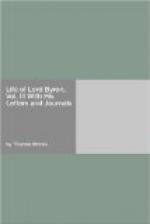In the Courier of May 13., the Brussels account of this transaction is thus copied:—
“The following is an extract from the Dutch Mail, dated Brussels, May 8th,:—In the Journal de Belgique, of this date, is a petition from a coachmaker at Brussels to the president of the Tribunal de Premier Instance, stating that he has sold to Lord Byron a carriage, &c. for 1882 francs, of which he has received 847 francs, but that his Lordship, who is going away the same day, refuses to pay him the remaining 1035 francs; he begs permission to seize the carriage, &c. This being granted, he put it into the hands of a proper officer, who went to signify the above to Lord Byron, and was informed by the landlord of the hotel that his Lordship was gone without having given him any thing to pay the debt, on which the officer seized a chaise belonging to his Lordship as security for the amount.”
It was not till the beginning of the following month that a contradiction of this falsehood, stating the real circumstances of the case, as above related, was communicated to the Morning Chronicle, in a letter from Brussels, signed “Pryce L. Gordon.”
Another anecdote, of far more interest, has been furnished from the same respectable source. It appears that the two first stanzas of the verses relating to Waterloo, “Stop, for thy tread is on an empire’s dust[107],” were written at Brussels, after a visit to that memorable field, and transcribed by Lord Byron, next morning, in an album belonging to the lady of the gentleman who communicates the anecdote.
“A few weeks after he had written them (says the relater), the well-known artist, R.R. Reinagle, a friend of mine, arrived in Brussels, when I invited him to dine with me and showed him the lines, requesting him to embellish them with an appropriate vignette to the following passage:—
“’Here
his last flight the haughty eagle flew,
Then tore, with
bloody beak, the fatal plain;
Pierced with the
shafts of banded nations through,
Ambition’s
life, and labours, all were vain—
He wears the shatter’d
links of the world’s broken chain.’
Mr. Reinagle sketched with a pencil a spirited chained eagle, grasping the earth with his talons.
“I had occasion to write to his Lordship, and mentioned having got this clever artist to draw a vignette to his beautiful lines, and the liberty he had taken by altering the action of the eagle. In reply to this, he wrote to me,—’Reinagle is a better poet and a better ornithologist than I am; eagles, and all birds of prey, attack with their talons, and not with their beaks, and I have altered the line thus:—
“‘Then tore, with bloody talon, the rent plain.’
This is, I think, a better line, besides its poetical justice.’ I need hardly add, when I communicated this flattering compliment to the painter, that he was highly gratified.”
From Brussels the noble traveller pursued his course along the Rhine,—a line of road which he has strewed over with all the riches of poesy; and, arriving at Geneva, took up his abode at the well-known hotel, Secheron. After a stay of a few weeks at this place, he removed to a villa, in the neighbourhood, called Diodati, very beautifully situated on the high banks of the Lake, where he established his residence for the remainder of the summer.




